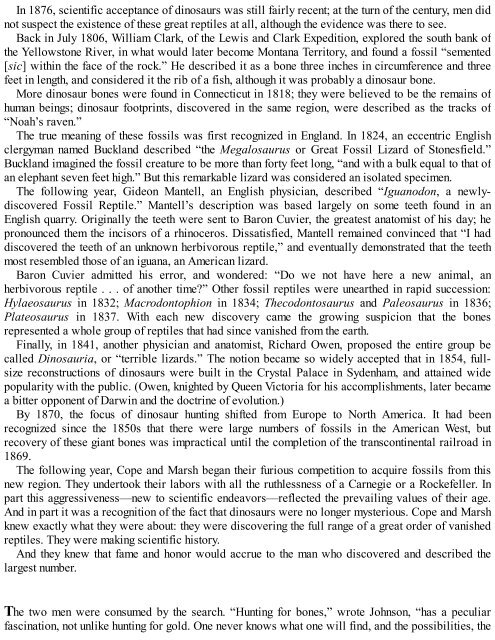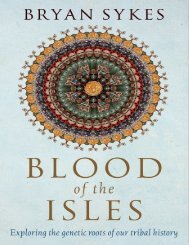You also want an ePaper? Increase the reach of your titles
YUMPU automatically turns print PDFs into web optimized ePapers that Google loves.
In 1876, scientific acceptance of dinosaurs was still fairly recent; at the turn of the century, men did<br />
not suspect the existence of these great reptiles at all, although the evidence was there to see.<br />
Back in July 1806, William Clark, of the Lewis and Clark Expedition, explored the south bank of<br />
the Yellowstone River, in what would later become Montana Territory, and found a fossil “semented<br />
[sic] within the face of the rock.” He described it as a bone three inches in circumference and three<br />
feet in length, and considered it the rib of a fish, although it was probably a dinosaur bone.<br />
More dinosaur bones were found in Connecticut in 1818; they were believed to be the remains of<br />
human beings; dinosaur footprints, discovered in the same region, were described as the tracks of<br />
“Noah’s raven.”<br />
The true meaning of these fossils was first recognized in England. In 1824, an eccentric English<br />
clergyman named Buckland described “the Megalosaurus or Great Fossil Lizard of Stonesfield.”<br />
Buckland imagined the fossil creature to be more than forty feet long, “and with a bulk equal to that of<br />
an elephant seven feet high.” But this remarkable lizard was considered an isolated specimen.<br />
The following year, Gideon Mantell, an English physician, described “Iguanodon, a newlydiscovered<br />
Fossil Reptile.” Mantell’s description was based largely on some teeth found in an<br />
English quarry. Originally the teeth were sent to Baron Cuvier, the greatest anatomist of his day; he<br />
pronounced them the incisors of a rhinoceros. Dissatisfied, Mantell remained convinced that “I had<br />
discovered the teeth of an unknown herbivorous reptile,” and eventually demonstrated that the teeth<br />
most resembled those of an iguana, an American lizard.<br />
Baron Cuvier admitted his error, and wondered: “Do we not have here a new animal, an<br />
herbivorous reptile . . . of another time?” Other fossil reptiles were unearthed in rapid succession:<br />
Hylaeosaurus in 1832; Macrodontophion in 1834; Thecodontosaurus and Paleosaurus in 1836;<br />
Plateosaurus in 1837. With each new discovery came the growing suspicion that the bones<br />
represented a whole group of reptiles that had since vanished from the earth.<br />
Finally, in 1841, another physician and anatomist, Richard Owen, proposed the entire group be<br />
called Dinosauria, or “terrible lizards.” The notion became so widely accepted that in 1854, fullsize<br />
reconstructions of dinosaurs were built in the Crystal Palace in Sydenham, and attained wide<br />
popularity with the public. (Owen, knighted by Queen Victoria for his accomplishments, later became<br />
a bitter opponent of Darwin and the doctrine of evolution.)<br />
By 1870, the focus of dinosaur hunting shifted from Europe to North America. It had been<br />
recognized since the 1850s that there were large numbers of fossils in the American West, but<br />
recovery of these giant bones was impractical until the completion of the transcontinental railroad in<br />
1869.<br />
The following year, Cope and Marsh began their furious competition to acquire fossils from this<br />
new region. They undertook their labors with all the ruthlessness of a Carnegie or a Rockefeller. In<br />
part this aggressiveness—new to scientific endeavors—reflected the prevailing values of their age.<br />
And in part it was a recognition of the fact that dinosaurs were no longer mysterious. Cope and Marsh<br />
knew exactly what they were about: they were discovering the full range of a great order of vanished<br />
reptiles. They were making scientific history.<br />
And they knew that fame and honor would accrue to the man who discovered and described the<br />
largest number.<br />
The two men were consumed by the search. “Hunting for bones,” wrote Johnson, “has a peculiar<br />
fascination, not unlike hunting for gold. One never knows what one will find, and the possibilities, the
















